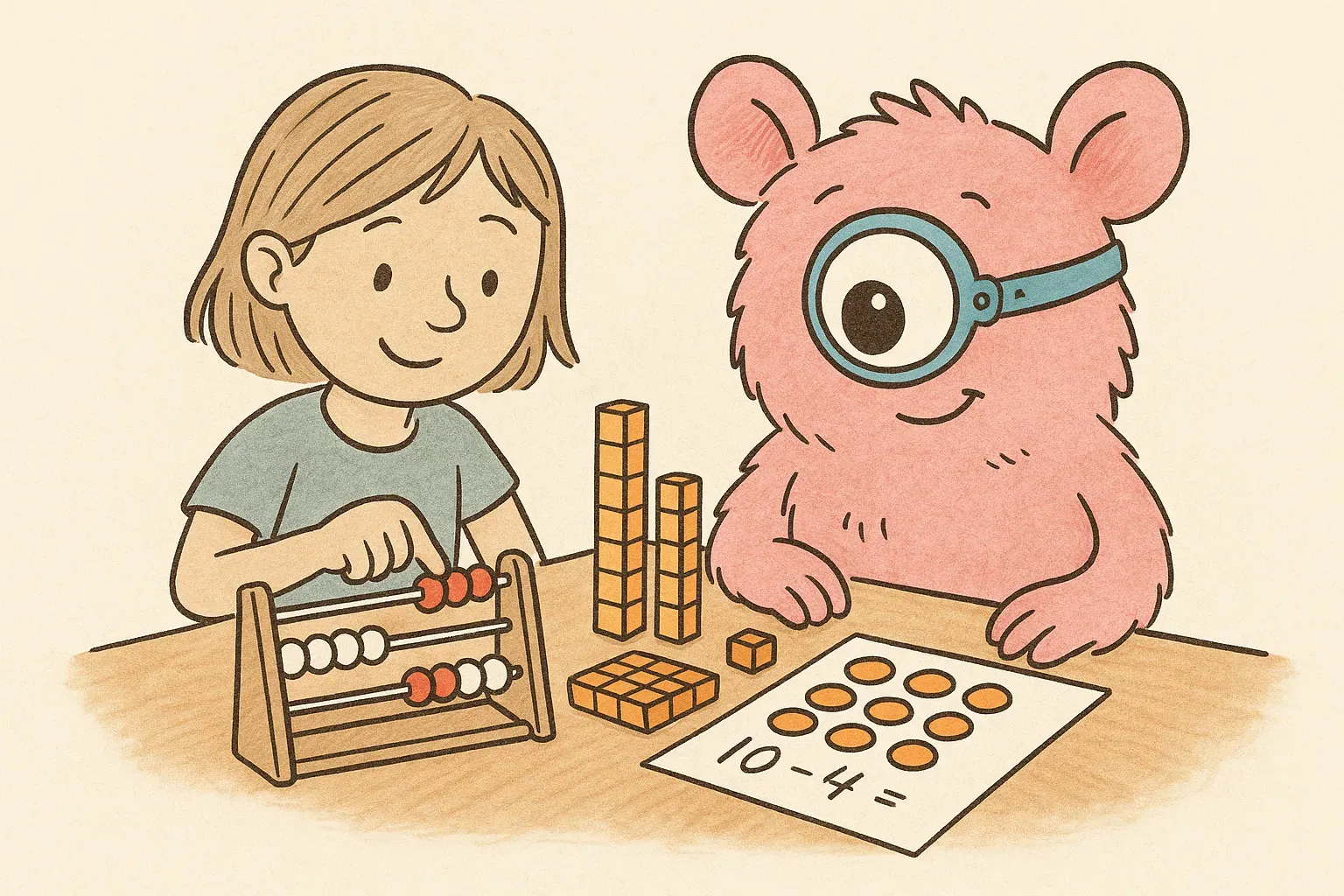Working Memory Hacks for Math Success in ADHD & Dyscalculia
TL;DR: Working memory - the “mental chalkboard” we use to hold numbers and steps - often runs near capacity for children with ADHD or dyscalculia. Evidence-based fixes include: adding visual cues and diagrams to offload steps, writing down intermediate results, using manipulatives to externalize thinking, building math fact fluency to free up cognitive resources, and scheduling short movement breaks or structured exercise. These approaches reduce cognitive load and measurably improve math performance in learners with working-memory vulnerabilities (see meta-analyses and experiments cited throughout).
If your learner starts a problem and “forgets where they are,” loses numbers mid-calculation, or needs to re-read word problems several times, you’re likely seeing working memory strain. Children with ADHD frequently show working-memory deficits alongside weaker multi-step math skills. Developmental dyscalculia is also strongly associated with working-memory weaknesses (including serial-order WM), which in turn disrupts numerical processing and problem solving (Mammarella et al., 2015; Dowker & Nuerk, 2024). A broad meta-analysis confirms that working memory and arithmetic are moderately correlated in primary-age learners (r≈.31), with verbal WM particularly important in early grades (Peng et al., 2023).
Below are practical, research-backed hacks parents and educators can use right away.
Hack 1: Add explicit visual cues and diagrams
When doing word problems, signal the essentials in word problems (underline the question, circle quantities, cross out distractors) and sketch the structure (part-whole bars, number lines, quick schematics). Instruction that teaches students to construct problem-appropriate diagrams enhances word-problem performance by easing the need to juggle details in mind (Ayabe et al., 2022). From a cognitive-load perspective, signaling and worked-example designs reduce extraneous processing and lighten working-memory demand—especially for novices (Paas & Sweller, 2020; Sweller, 2024). Even small cues can lower cognitive load and improve learning efficiency in math contexts (Kim et al., 2020).
Do this: Make cueing a routine - write the question in your own words, box the operation, draw a quick bar model.

See our visual strategy playbook in How to Reduce Math Cognitive Load (Without Dumbing It Down).
Hack 2: Offload steps - write, don’t just think
Encourage students to externalize intermediate results (partial sums, carries, sub-goals) on paper or whiteboards. This is cognitive offloading: shifting information to the environment to reduce internal WM demands. Experimental work shows that offloading reliably boosts in-task performance, particularly for learners with lower working-memory capacity, even if it can trade off with later recall of the offloaded info (Risko et al., 2021; Marris et al., 2019). Practically, it means: write the plan, then work the plan.
Do this: Use step checklists for long division or multi-step equations; jot sub-results rather than “holding” them mentally.
For multi-step memory relief, pair this with our guide: It’s Not the Numbers - It’s the Memory.
Hack 3: Make thinking tangible with manipulatives
Manipulatives (counters, base-ten blocks, fraction bars, abacus/rekenrek) extend the learner’s “workspace” into the world, reducing the need to mentally track every element. A large peer-reviewed meta-analysis (55 studies; K–college) found statistically significant, small-to-moderate benefits for achievement when teaching mathematics with concrete manipulatives versus symbols alone (Carbonneau, Marley, & Selig, 2013). Recent reviews continue to support manipulatives when attention is guided to the mathematically relevant features (Laski et al., 2015).

Do this: For ADHD/dyscalculia, prefer structured tools (e.g., rekenrek’s 5-and-5 bead pattern) that cue number structure and minimize distraction.
See our primer: How Rekenreks Build Number Sense.
Hack 4: Build math fact fluency to free working memory
Automatic retrieval of basic facts (e.g., 7×8=56) liberates working memory for reasoning. A comprehensive meta-analysis shows a robust association between working memory and arithmetic in primary grades, highlighting why building automaticity reduces WM load during problem solving Peng et al., 2023. Instructional theory converges: by lowering element interactivity (e.g., via worked examples and spaced practice), we free cognitive resources for higher-order steps Paas & Sweller, 2020; Sweller, 2024.
Do this: Use short, low-pressure daily practice with immediate feedback; emphasize strategy-based fact learning (doubles, near-doubles, making 10) over pure rote. For a mindset-friendly nudge, share Why Your Child Needs Math Wins (Not Drills).
Also consider using Monster Math to build your child's Math fact fluency.
Hack 5: Use movement and exercise to “reboot” working memory
Well-designed movement breaks and structured exercise can acutely sharpen executive functions and, over weeks, improve working memory in ADHD. Multiple meta-analyses report benefits of physical activity for executive function, with chronic programs showing clearest gains for working memory in ADHD samples Song et al., 2023; Liang et al., 2021. Recent network/meta-analyses suggest cognitively engaging activities (e.g., ball games, martial arts, dual-task games) may yield the largest WM effects for ADHD Song et al., 2025; Cheng et al., 2025.
Do this: Insert 2–3 minute “brain breaks” after 15-20 minutes of math. Over weeks, trial 45–60 minute, 1–2×/week programs learners enjoy (e.g., dance circuits, ball skills, martial arts). For home routines that fit real family life, lean on Daily Math Routines for ADHD Kids.
Putting it together
- Always offload first: cue, sketch, and write steps before solving.
- Make it tangible: choose manipulatives that reveal structure (5-and-10 patterns, unit/tens blocks).
- Automate the basics: short, positive fact practice so WM can focus on reasoning.
- Move often: brief active resets during study; sustained, engaging programs across weeks.
These hacks don’t “fix” a child; they fix the task so it fits how their brain works. With fewer items to juggle, learners can direct effort toward understanding, strategy, and confidence.
FAQs
Why do kids with ADHD struggle specifically with multi-step math?
ADHD commonly co-occurs with working-memory weaknesses and slower integration of steps, which undermines multi-step calculations and word problems (Gaye et al., 2023). Offloading steps and using visual diagrams reduce the cognitive “juggling” (Ayabe et al., 2022).
How is dyscalculia’s working-memory profile different?
Many learners with dyscalculia show deficits in serial-order and visuospatial WM that make holding and manipulating quantities harder (Mammarella et al., 2015); broader reviews converge on WM as a key constraint for dyscalculia (Dowker & Nuerk, 2024).
Do manipulatives actually help beyond the “feel-good” factor?
Yes - when used with clear goals. A meta-analysis across 55 studies found small-to-moderate achievement benefits for manipulatives, moderated by how they’re used (Carbonneau et al., 2013). Guide attention to the relevant mathematical features (Laski et al., 2015).
Will working-memory “training apps” raise math scores?
Standalone WM training shows mixed transfer to academics; pairing memory practice with explicit math strategies (e.g., diagramming) is more promising (Ayabe et al., 2022). For everyday gains, prioritize offloading, cueing, and manipulatives.
What kind of exercise works best for ADHD and WM?
Chronic programs help most; cognitively engaging activities (martial arts, ball games, dual-task games) often outperform simple aerobic routines for WM outcomes in ADHD (Song et al., 2025; Cheng et al., 2025).
References
- Ayabe, H., Fazio-Bradley, R., & Nathan, M. J. (2022). Problem-appropriate diagram instruction for improving mathematical word-problem solving. Journal of Numerical Cognition. Open access
- Carbonneau, K. J., Marley, S. C., & Selig, J. P. (2013). A meta-analysis of the efficacy of teaching mathematics with concrete manipulatives. Journal of Educational Psychology, 105(2), 380–400. Publisher record
- Cheng, G., Zhang, R., Zhou, L., et al. (2025). The impact of physical activity on working memory in children with ADHD: A meta-analysis. Frontiers in Psychiatry. Open access
- Dowker, A., & Nuerk, H.-C. (2024). Developmental dyscalculia in relation to individual differences in numerical abilities and cognitive functions. Frontiers in Psychology, 15. Open access
- Gaye, F., Langberg, J. M., & Mahone, E. M. (2023). Working memory and math skills in children with and without ADHD. Neuropsychology. PDF
- Kim, K., et al. (2020). The effect of visual cues on cognitive load depending on learners’ characteristics. Proceedings of EDM 2020. PDF
- Liang, X., et al. (2021). The impact of exercise interventions on executive functions in children and adolescents with ADHD: A meta-analysis. International Journal of Behavioral Nutrition and Physical Activity, 18, 68. Open access
- Laski, E. V., et al. (2015). What makes mathematics manipulatives effective? SAGE Open, 5(2). Open access
- Mammarella, I. C., et al. (2015). Working memory deficits in developmental dyscalculia. Child Neuropsychology, 21(3), 367–384. PubMed
- Marris, E., Kalogeropoulos, G., & Risko, E. F. (2019). Offloading items from memory: Individual differences in cognitive offloading. Cognitive Research: Principles and Implications, 4, 58. Open access
- Paas, F., & Sweller, J. (2020). Methods to manage working memory load in the learning of complex cognitive tasks. Current Directions in Psychological Science, 29(4), 394–398. Publisher
- Peng, P., et al. (2023). The relationship between working memory and arithmetic in primary school children: A meta-analysis. Brain Sciences, 13(1). Open access
- Risko, E. F., et al. (2021). Consequences of cognitive offloading: Boosting performance but sometimes at a cost to memory. Memory & Cognition, 49, 1621–1635. Open access
- Song, Y., et al. (2023). Effects of physical activity on executive functions in children and adolescents with ADHD: A meta-analysis. PLOS ONE, 18(9), e0289732. Open access
- Song, X., et al. (2025). Exploring the impact of different types of exercise on working memory in children with ADHD: A network meta-analysis. Frontiers in Psychology. Open access
- Sweller, J. (2024). Cognitive load theory and individual differences. Learning and Instruction, 89, 101738. Publisher

